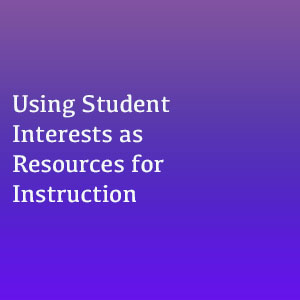More often than not we come across curriculum topics that are in the real-world and have been repeatedly taught, yet it is like the students are being introduced to it for the first time. Over. And. Over. We have all asked ourselves, “What is going on? I just taught this YESTERDAY.” From my experiences, I believe one answer to this dilemma is that we continue to generalize students and what they will connect to. Even with all of the differentiation strategies, individualized support, and additional staff members, adults are making assumptions about the kids in their classrooms. What educator at one point or another hasn’t planned a lesson or activity that will connect to ‘kids these days’? Too often we assume that because something is available to the general public that students will immediately have a connection to it. Availability does not equal interest.
A great example of this came from a teacher collaboration meeting in an urban, elementary charter school that is serving a diverse population of students. A third-grade teacher shared her struggles with teaching the use of quotation marks to her class. She followed a clear lesson structure of introducing what quotation marks are with examples from newspaper articles. The students were well-behaved during the lesson, but the check for understanding proved little to no retention. Through discussion, we came to the conclusion that, although students know what a newspaper is, this particular population of students did not have daily experiences with newspapers, and therefore could not make a direct cognitive link to store new information about quotations. Self-reflection enlightened the root of the issue: the teacher had made an assumption on an “obvious” resource to share with the students, as newspapers are public and available locally, but did not take her students’ demographics, interests, or daily routines in mind when making that choice.
Are newspapers widely available? Yes.
Do they use quotation marks? Yes.
Do the students regularly use newspapers for news updates? No.
Do the households of the children receive newspapers? Maybe.
Do adults in the household actively share newspapers with the children for reading material? Probably not.
The fix to this is nothing new. The framework has been around for what seems like forever, but the idea may come and go from our list of priorities as educators. Are you ready? ASK YOUR STUDENTS ABOUT THEMSELVES. We need to ask our students who they are, what they are about, what they are interested in, and who they want to become. Not just for the purpose of building personal relationships, but to improve instructional connections to our students. Cognitive research shows that student interest is an influential factor in engagement and neurological connections to new information. The stronger the information or skill connects to the daily life of the student, the stronger the probability of it moving from working to long-term memory. Not every school is the same, not every urban population is the same, not every 3rd grader is the same, so why are we using the same examples and resources year after year? Making assumptions about what will engage our students ends up being more work than allowing the students to take the lead (due to the re-teach, adaptations, and updates to the lesson after the fact). Let me share the strategy that was used by the third-grade teacher:
I Like to… Board
This activity is simple, flexible, student-driven, and useful across grade levels and content areas. The set-up includes an anchor chart, bulletin board or other wall space having the title “I Like To…” posted. Students are provided with sticky notes and instructed to complete the prompt. The expectations are:
- only one interest/idea/topic written per sticky note
- the topic is specific (ex: a student cannot write ‘sports’. What sport? What team? What players?)
- the topic is school-appropriate
- no names are written on the sticky notes
Students have the freedom to write as many or as little interests as they want. Once an allotted amount of time is done (3-5 minutes recommended), students post their sticky notes to the wall. From then on, teachers AND students can reference the interests of the class throughout the day. That’s right. Teachers are not the only ones that benefit from an easy, available, and relevant ‘icebreaker’ with other students.
This has worked extremely well in the third-grade classroom and others due to the adaptability of the wall. Some suggestions for use from teachers include:
- Teachers can read the interests to the class after posting, plan a small group activity, and use the resource later in the day.
- Many times, a pattern or trend can be seen across multiple notes, making these an easier reference point for the teacher. If interests or topics are repeated, stick the notes on top of one another for organization.
- The wall should be referenced at least once per day (if not more!) to build the strategy into the classroom culture and maintain instructional accountability for curriculum connections.
- Once a topic has been used in a lesson (whether as an example or a resource) it may be removed from the wall or an identifying mark made on the sticky note.
- The wall may be updated weekly, monthly, or quarterly. It is suggested that the length of time is no longer than quarterly as the goal is to keep the wall relevant and in tune to current student interests. If the culture of the classroom supports it, students can add sticky notes on their own time.
- Students may use sticky notes as ‘talking points’ to practice appropriate conversation style, brainstorm ideas for writing topics, or participate in a structured ‘getting to know you’ activity anytime throughout the year. Interests are constantly changing so no need to worry about repetitive topics.
From this strategy, the third-grade teacher was able to re-teach quotation marks using song lyric references and current articles from online news sources. All resources were on a specific topic pulled from the “I Like to…” sticky notes. The check for understanding showed astronomical gains from the prior lesson. It has been three months since her implementation of the board and she continues to have positive feedback about the ease of lesson references, student involvement, and a decrease in the need to re-teach curricular content. The only talking point that remains on this strategy is the teacher not knowing anything about some of the topics that students write on the board. We all want to be genuinely interested in what the students are, but sometimes cultural and generational divides are far too great for the truth. My recommendation? ASK YOUR STUDENTS. Don’t be surprised by how much they are willing to share.








